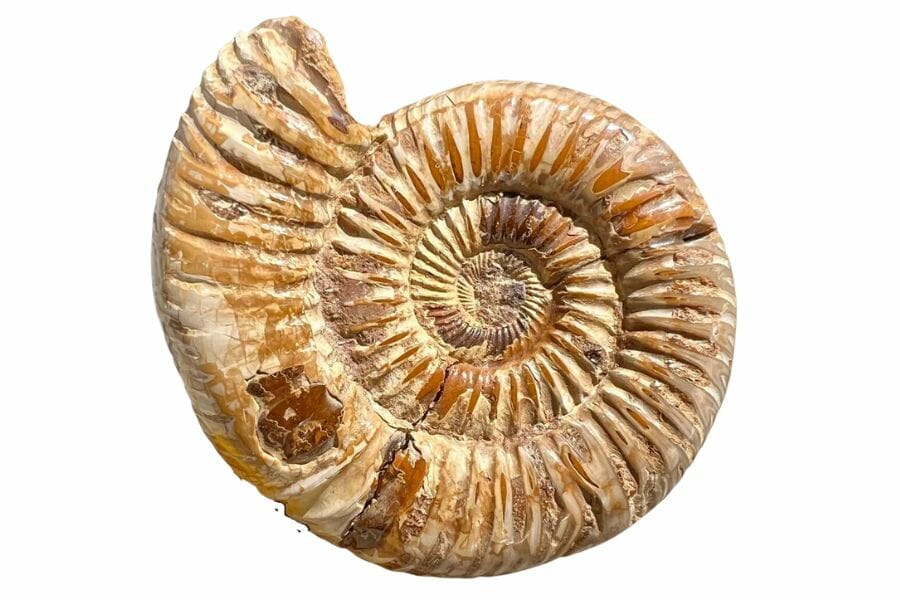Every rock layer and twist in Indiana’s terrain offers a new chapter in Earth’s history. Hunting for Indiana fossils is like flipping through the pages of a captivating book, giving us a chance to understand our planet’s history.
Finding fossils around the state can be tricky though. There is so much area to cover! To help you find success we’re going to share some of our favorite places to find fossils in Indiana that you need to try out.
As you stroll through forests, walk along riverbeds, or hike the hills, you’ll find a wide variety of fossils. You might even find them when you least expect it. So make sure to keep your eyes peeled on your explorations!
The Fossils Of Indiana You Can Find
The fossils of Indiana provide clues about creatures and plants that once called this place home. Once you start exploring the state, you’ll be able to uncover these natural treasures that offer a glimpse into a different time.
While searching for fossils, you might also be interested in finding other geological wonders. Check out our Indiana rockhounding guide to discovering unique rocks, minerals, and gems throughout the state.
- The extensive local experience and understanding of our team
- Input from multiple local fossil hunters and fossil groups
- The accessibility of the various locations
- Safety and potential hazards when collecting
- Private and public locations
- A desire to include locations for both experienced fossil lovers and those who are just starting out
Using these weights we think we’ve put together the best list out there for those who love finding great new fossils for our collections!
Common Indiana Fossils
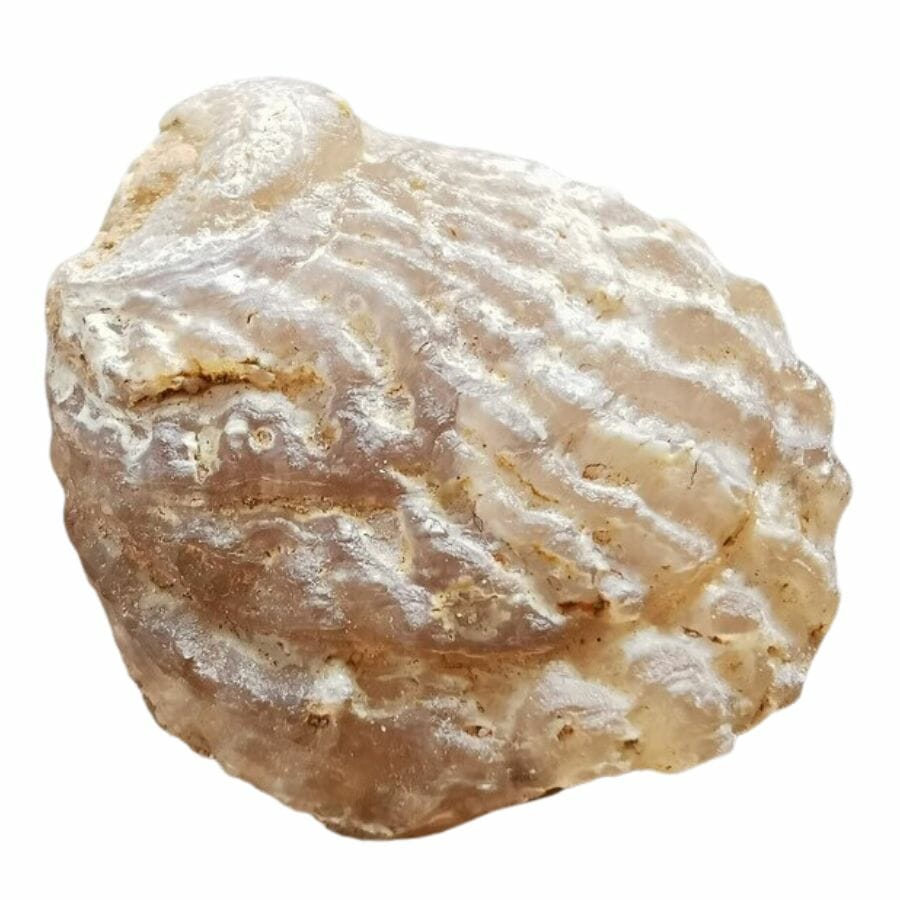
Here’s a list of the common fossils in Indiana that enthusiasts often come across:
- Brachiopods
- Bryozoans
- Cephalopods
- Crinoids
- Gastropods
- Pelecypods
- Trilobites
- Corals
- Bivalves
- Graptolites
Indiana State Fossil – American Mastodon
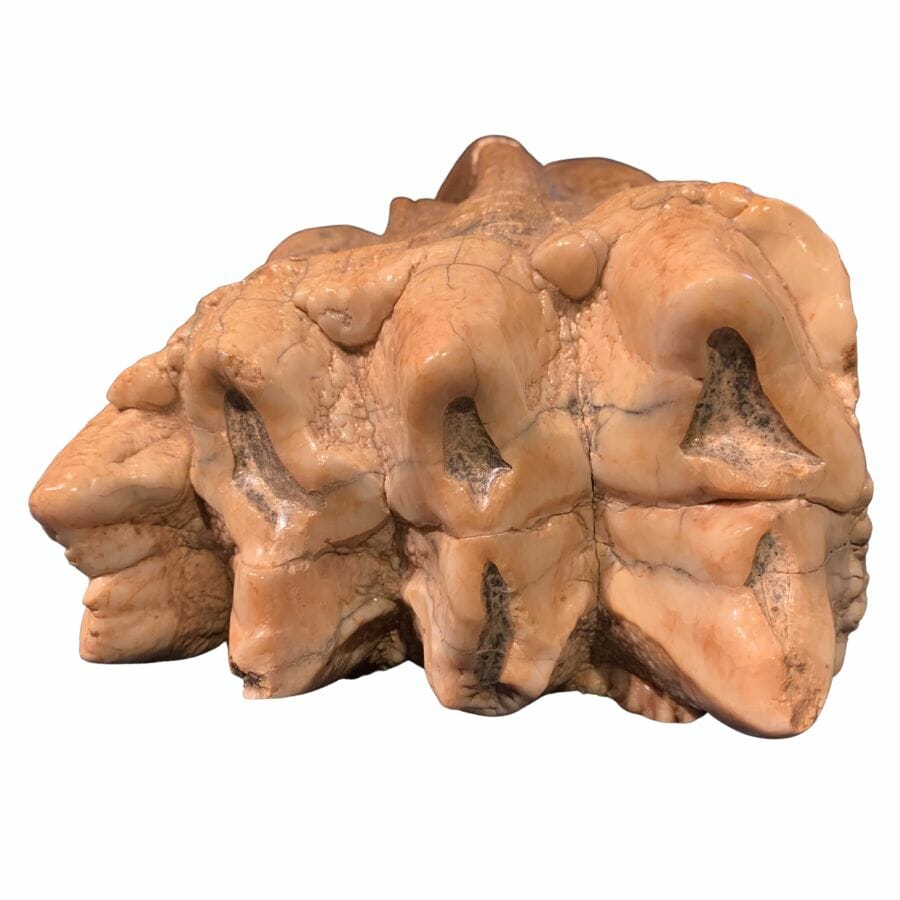
The American mastodon is a fascinating prehistoric mammal, similar in size to today’s elephants. These creatures roamed North America, including Indiana, thousands of years ago.
With long, curved tusks and a shaggy coat, they were herbivores, munching on plants in their environment. As the state fossil of Indiana, the mastodon holds a special place in the state’s history and showcases a piece of its prehistoric past.
Rare Indiana Fossils
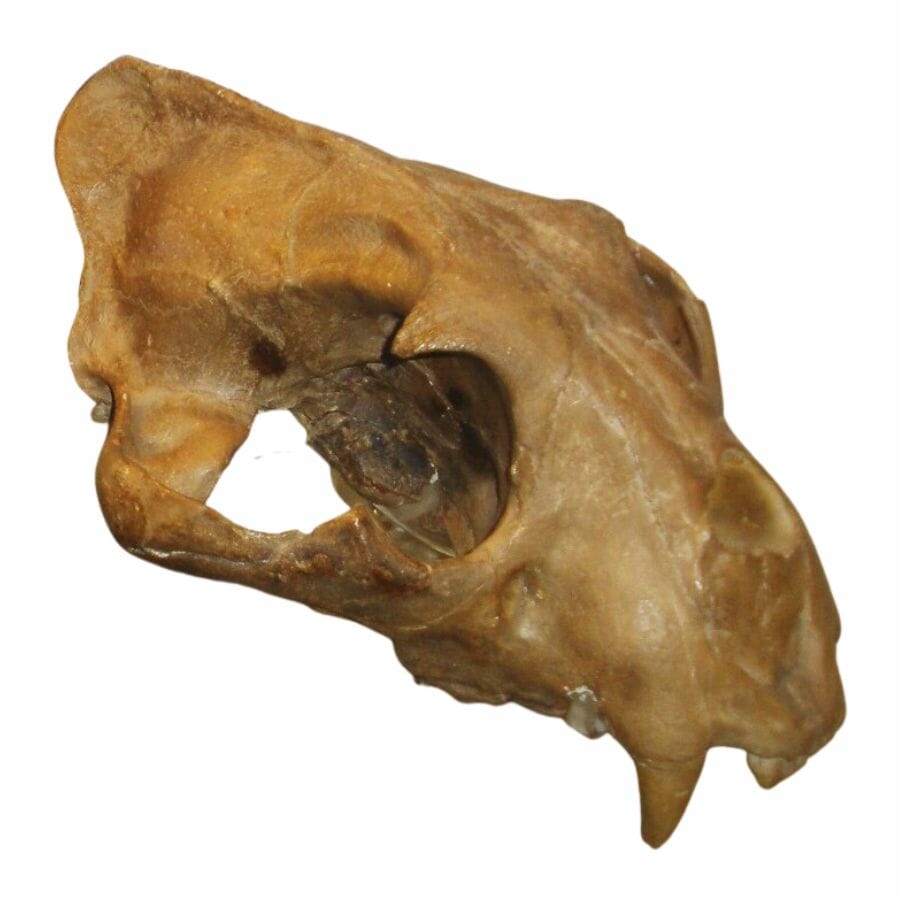
Indiana is also home to some valuable rare Indiana fossils. Let’s take a look at the rarest fossils you can find in the state!
- Mammal bones
The Best Places To Find Fossils In Indiana
From riverbanks to rocky outcrops, there are spots peppered throughout the state that are fossil hotspots. Let’s dive into these locations and discover where you’re most likely to stumble upon these natural treasures!
Always Confirm Access and Collection Rules!
Before heading out to any of the locations on our list you need to confirm access requirements and collection rules for both public and private locations directly with the location. We haven’t personally verified every location and the access requirements and collection rules often change without notice.
Many of the locations we mention will not allow collecting but are still great places for those who love to find beautiful rocks and minerals in the wild without keeping them. We also can’t guarantee you will find anything in these locations since they are constantly changing.
Always get updated information directly from the source ahead of time to ensure responsible rockhounding. If you want even more current options it’s always a good idea to contact local rock and mineral clubs and groups
Whitewater Valley
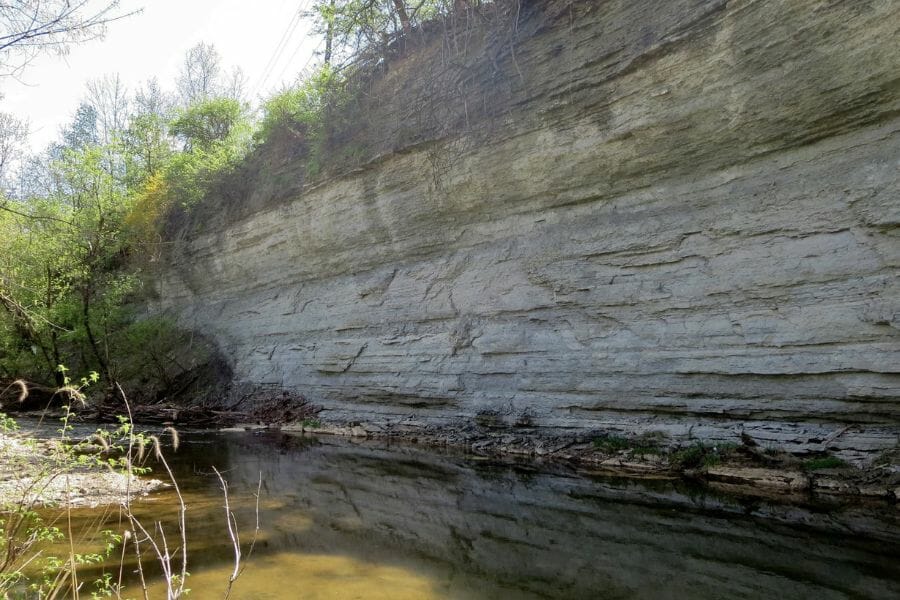
The Whitewater Valley is a remarkable spot known for its scenic beauty and geological wonders. The area is characterized by rolling hills, lush valleys, and the prominent Whitewater River that flows through, carving its path over time.
This river has played a significant role in shaping the terrain, creating a diverse range of landscapes from steep gorges to broad floodplains.
The geology of the region is just as captivating. A blend of sedimentary rocks, such as limestone and shale, tells stories of the environments from long ago.
Over time, these rocks have been shaped, eroded, and deposited, leaving behind a playground for rockhounds and nature enthusiasts alike.
Major roads and highways lead directly to the Whitewater Valley, making it accessible for both day-trippers and those planning longer stays.
There are different trails and overlooks that you can use, offering breathtaking views and the chance to delve deeper into the earth’s history.
Where to find fossils in the Whitewater Valley
The riverbanks and shallow stream beds are prime spots to discover common Indiana fossils found there. Limestone outcrops in the area also reveal embedded fossils.
Explorers keen on uncovering these treasures often head to these specific terrains in Whitewater Valley to start their fossil-hunting journey.
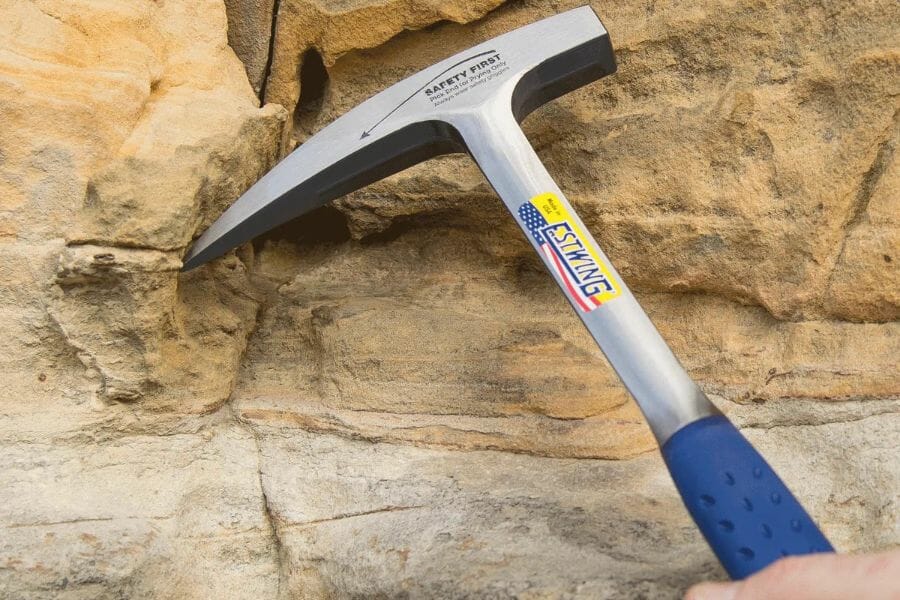
The tools every fossil hunter will need
When you're out looking for fossils having the right tools for the job is really going to make or break your success. You don't need a lot for most trips but there are a handful that are critical and will make your life a lot easier.
We get asked a lot about the equipment we use. Over the years we've found a handful of tools that we recommend to both new and experienced fossil hunters which we outline in great detail in our complete rockhounding tools and kit guide. These are quality options that also happen to be relatively inexpensive.
Below are the basic tools that make your life so much easier and save you a ton of time. Check out the full guide to see everything we recommend bringing. One quick note, as an Amazon Associate I earn from qualifying purchases but we try very hard to only recommend gear we would use ourselves and often recommend brands you can't find on Amazon.
At a minimum you should have:
1 - Sturdy rock hammer: The Estwing Rock Pick is our standard
2 - Rugged chisels: Try Kendo' 3-piece Chisel Set
3 - Compact shovel: The Koleiya 28-inch shovel works well
4 - Rock screen pan: The Wazakura Soil Sieve Set fits the bill
5 - Eye protection: DeWalt Safety Glasses are cheap and comfortable
6 - Head protection: Malta's Safety Helmet has been our go-to
7 - Jewelers lens with at least 20x magnification: Jarlink's Jewelers Loop is perfect
The fossil-finding books that we use most
There are also a few books that have been extremely helpful in the search for gems. These books have great recommendations and tips:
National Audubon Society Field Guide to Rocks and Minerals: North America
Northeast Treasure Hunter's Gem & Mineral Guide
Earth Treasures: The Northeastern Quadrant
We provide links to find these tools on Amazon but some can also be found at your local hardware stores. For more recommendations check out the link to our full tool guide above.
Falls of the Ohio State Park
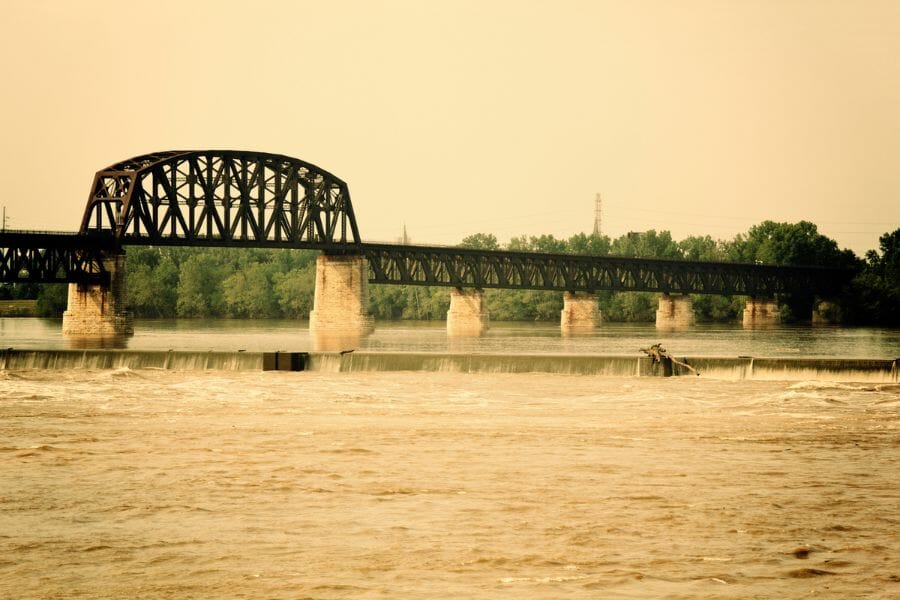
The Falls of the Ohio State Park’s standout feature is its exposed fossil beds along the Ohio River.
These beds are home to an impressive variety of fossils, revealing the diverse creatures that once inhabited the region.
The terrain itself is a mix of rippling water, riverbanks, and rugged rock surfaces. The park’s geology is mainly limestone, shaped and carved over time by the flow of the Ohio River.
This interaction between water and rock has not only sculpted the landscape but has also exposed the remarkable fossil formations.
The Falls of the Ohio State Park welcomes visitors throughout the year. It has clearly marked routes and clear signage, so getting there is easy.
Once there, a network of paths and viewpoints allows everyone to explore and appreciate the geological wonders and the serene beauty of the river.
Where to find fossils in the Falls of the Ohio State Park
The exposed river beds in the Falls of the Ohio State Park reveal a diverse collection of marine fossils, including corals, brachiopods, and trilobites.
Those eager to discover these fossils should focus on the limestone outcrops and riverbanks.
Turkey Run State Park
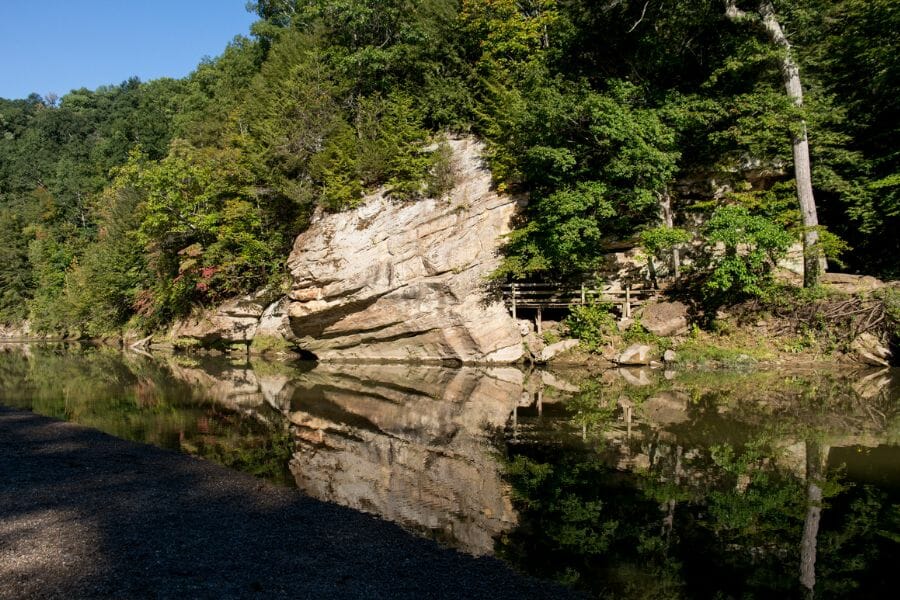
Turkey Run State Park is a captivating destination that showcases the beauty and wonder of nature. This park is known for its deep canyons formed by Sugar Creek, dramatic sandstone cliffs, and scenic forested landscapes.
These natural formations are rich in geology, revealing layers of sandstone and coal that provide insights into the Earth’s history.
For those keen on fossil hunting in Indiana, the park’s rocky terrain offers opportunities to uncover different kinds of fossils.
The diverse terrain of the park, from its gushing streams to steep ravines, makes it a popular spot for outdoor enthusiasts. Whether you’re hiking, picnicking, or simply enjoying nature, the park promises a rewarding experience.
Well-marked roads lead to the park’s entrance, and ample signage ensures that visitors can easily navigate the area.
Once inside, a network of trails invites everyone to explore and appreciate the geological wonders and the beauty of the surroundings.
Where to find fossils in Turkey Run State Park
As visitors hike through the park’s canyons and along the banks of Sugar Creek, they can spot a variety of marine fossils embedded in the sandstone layers. These include traces of corals, brachiopods, and even crinoids.
The best spots to discover these fossils are the exposed rock surfaces and the creek’s water-worn stones.
Cardinal Greenway
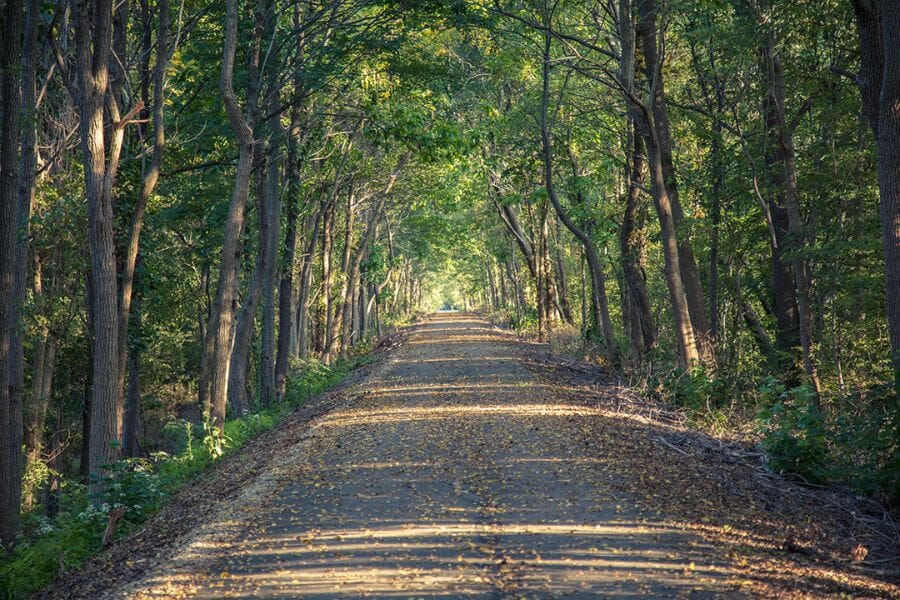
The Cardinal Greenway is a remarkable trail that stretches over miles, making it the longest rail-trail in the state. Originally a railroad corridor, this pathway has been transformed into a haven for hikers, bikers, and nature enthusiasts.
Its terrain is mostly flat and paved, offering an easy journey through scenic landscapes, woodlands, and charming towns.
While primarily known for its recreational appeal, the trail also passes through areas rich in geology. Here, one can spot limestone outcroppings and shale layers, which occasionally reveal the different fossils of Indiana.
Reaching the Cardinal Greenway is simple, as it intersects with many local roads and highways. With clear markings and plenty of access points, visitors can jump onto any section of the trail and start their adventure.
Where to find fossils in Cardinal Greenway
Along the Cardinal Greenway, there are areas with exposed rock, mainly limestone and shale. These rocks occasionally showcase fossils, hinting at a rich marine past.
Travelers often spot traces of corals, brachiopods, and other marine creatures embedded in these rocks. To find these fossils, it’s best to focus on the rock outcroppings and the areas where the trail cuts through the natural terrain.
Thistlethwaite Falls
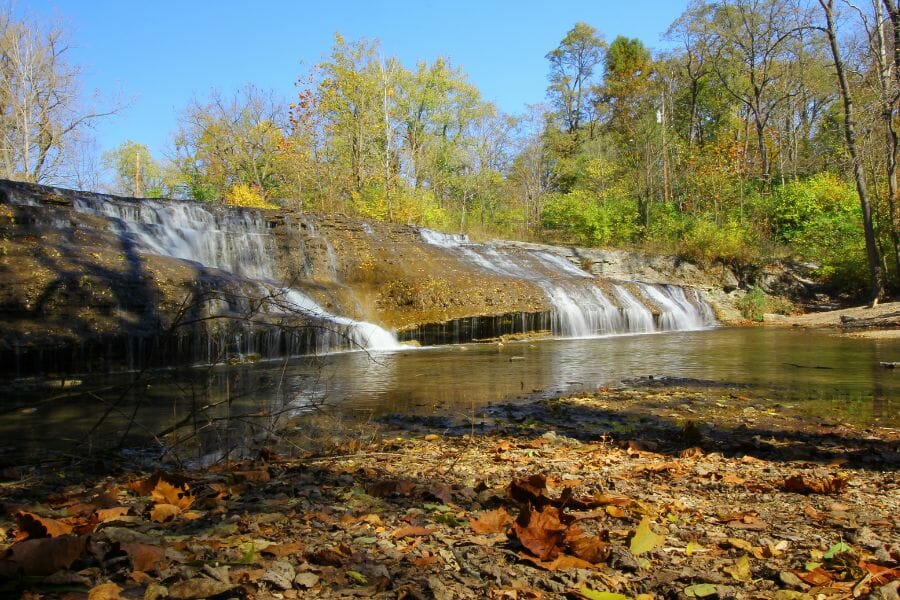
Thistlethwaite Falls is a captivating natural wonder that stands as a testament to the power of flowing water over time. Nestled in a serene setting, the falls cascade over multiple rock layers.
The terrain around the falls is rugged and rocky, with outcroppings that reveal a rich geological history. Layers of limestone and shale tell tales of times gone by, and the constant erosion by the falls continues to shape and mold the landscape.
For those keen on exploring, the rocks near the base of the falls can occasionally unveil traces of marine life from eons ago.
Clear pathways lead to viewing spots in Thistlethwaite Falls, and the falls themselves are conveniently accessible from nearby roads.
Where to find fossils in Thistlethwaite Falls
The rock layers around Thistlethwaite Falls, primarily limestone and shale, contain imprints of marine creatures like corals and brachiopods.
For those keen on fossil hunting in Indiana, focusing on the exposed rock outcroppings near the base of the falls can yield fascinating finds.
Other Top Places To Find Indiana Fossils By Region
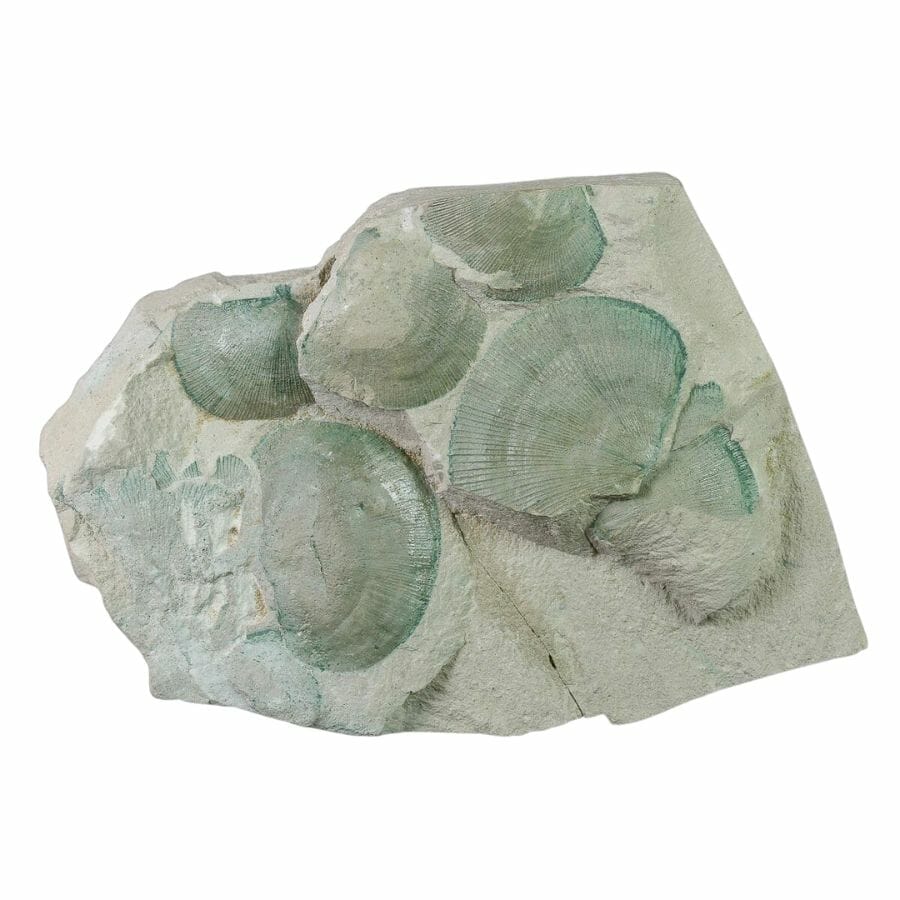
You can also try your luck in a variety of other spots around the state. Here’s a list of these fantastic fossil-finding areas.
Do not include more than 60 recommendations
| Location | Fossils |
| Wabash River Valley | Gastropods, bivalves, ostracods |
| Jay City, Adams County | Favosites, Halysites, Heliolites, Zaphrentis, Atrypa, Leptaena, Meristina, Pentamerus, Stropheodonta, Orthoceras |
| Woodburn, Allen County | Cnidarians, crinoids, bryozoa, placoderms, trilobites, brachiopods, ostracods, corals, trace fossils |
| Hartsville, Bartholomew County | Brachiopods, blastoids, corals, trilobites,crinoids |
| Delphi, Carroll County | Conularids, brachiopods |
| Georgetown, Cass County | Brachiopods, corals, stromatoporoids, silicified shells |
| Charlestown, Clark County | Bryozoa Syringopora, pelecypod Paracyclas, brachiopods |
| Coal City, Clay County | Corals, brachiopods, microfossils |
| Sulphur, Crawford County | Brachiopods, blastoids, crinoids, pelecypods, bryozoa, brachiopods, gastropods, conularids, horn corals, shark teeth and scales, cephalopods, trace fossils, trilobites, invertebrates |
| Weisburg, Dearborn County | Sowerbyella, Platystrophia, Rafinesquina, trilobites |
| Holland, Dubois County | Annelids, crinoid columnals, bryozoa, brachiopods, gastropods; ostracods, trilobite, conodonts |
| Floyds Knobs, Floyd County | Brachiopods, bryozoa, crinoids, ichnofossils |
| St Mary’s, Franklin County | Leptaena, Platystrophia, Rafinesquina, Rhynchotrema, Dalmanella, Hebertella, Byssonychia, bivalves, Cyclonema, Flexicalymene, bryozoa |
| Fairmount, Grant County | Beaver Castoroides |
| Ridgeport, Greene County | Crinoid stems, brachiopods, Martinia, Composita, Cleiothyridina, Echinoconchus, Productus, Linoproductus, bryozoa, blastoids, gastropods |
| Lanesville, Harrison County | Chomatodus, Chromatodus, Cladodus, Ctenacanthus, Deltodus, Deltopsis, Helodus, Orodus, Psephodus, Sandalodus |
| Kokomo, Howard County | Algae, Ceratiocaris, Buthotrephis, Eurypterus, Eusarcus, Stylonurus, graptolites |
| Huntington, Huntington County | Graptolites, brachiopods, corals, stromatoporoids, gastropods, bryozoa, trilobites |
| Rockford, Jackson County | Ammonites |
| New Corydon, Jay County | Favosites, Halysites, Heliolites, Zaphrentis, Atrypa, Leptaena, Meristina, Pentamerus, Stropheodonta, Orthoceras |
| Madison, Jefferson County | Coral, gastropods, brachiopods, bryozoa, gastropods, bivalves, cephalopods, trilobite |
| Wheatland, Knox County | Plants, petrified wood |
| Bryantsville, Lawrence County | Pugnoides, Platycrinus, Lithostrotion |
| Greenbriar, Madison County | Antliodus, Archaeobatis, Cladodus, Cladoselache, Deltodus, Labodus, Physonemus, Polyrhizodus, Psammodus, Sandalodus |
| Peru, Miami County | Ichnofossils |
| South of Bloomington, Monroe County | Corals, brachiopods, crinoids |
| Crawfordsville, Montgomery County | Archimedes |
| Hartford, Ohio County | Crinoids, gastropods, trilobites, corals |
| French Lick, Orange County | Brachiopods, bivalves, cephalopods, bryozoa |
| Gosport, Owen County | Crinoid stems, brachiopods, gastropods |
| Montezuma, Parke County | Shark teeth |
| Derby, Perry County | Listracanthus, Petrodus |
| Augusta, Pike County | Pentremites, bryozoa, crinoids, trilobite pygidia, brachiopods |
| West Franklin, Posey County | Brachiopods, crinoid stems, gastropods, bivalves, plant fossils |
| LOCATION | FOSSILS |
| Ridgeville, Randolph County | Brachiopods, gastropods, corals, microfossils |
| Osgood, Ripley County | Pentamerus |
| Waldron, Shelby County | Anthozoa, stromatoporoids, bryozoa, brachiopods, cephalopods, trilobites |
| Mount Sterling, Switzerland County | Brachiopods, crinoids, blastoids |
| West Point, Tippecanoe County | Brachiopods, bryozoa, bivalves, gastropods, cephalopod |
| Brownsville, Union County | Nautilus, spirifer, Productus, Discina, Terebratula, Lingula |
| Liberty, Union County | Calymene |
| Evansville, Vanderburgh County | Corals, brachiopods, bryozoa, Flexicalymene, trilobites, crinoids |
| Vermillion County | Brachiopods, blastoids, trilobites, gastropods, corals, microfossils, Pecopteris, Neuropteris, calamites |
| Blackhawk, Vigo County | Pelecypods |
| West Lebanon. Warren County | Calymene |
| Boonville, Warrick County | Trilobites, brachiopods, corals, crinoid stems, protozoa, ostracods |
| Canton, Washington County | Plant and marine fossils |
| Richmond Fossil Park, Wayne County | Nautilus, Spirifera, Productus, Discina, Terebratula, Lingula |
| Camden, White County | Brachiopods, corals, mollusks, stromatoporoids, trilobites |
Common Questions About Fossil Hunting In Indiana
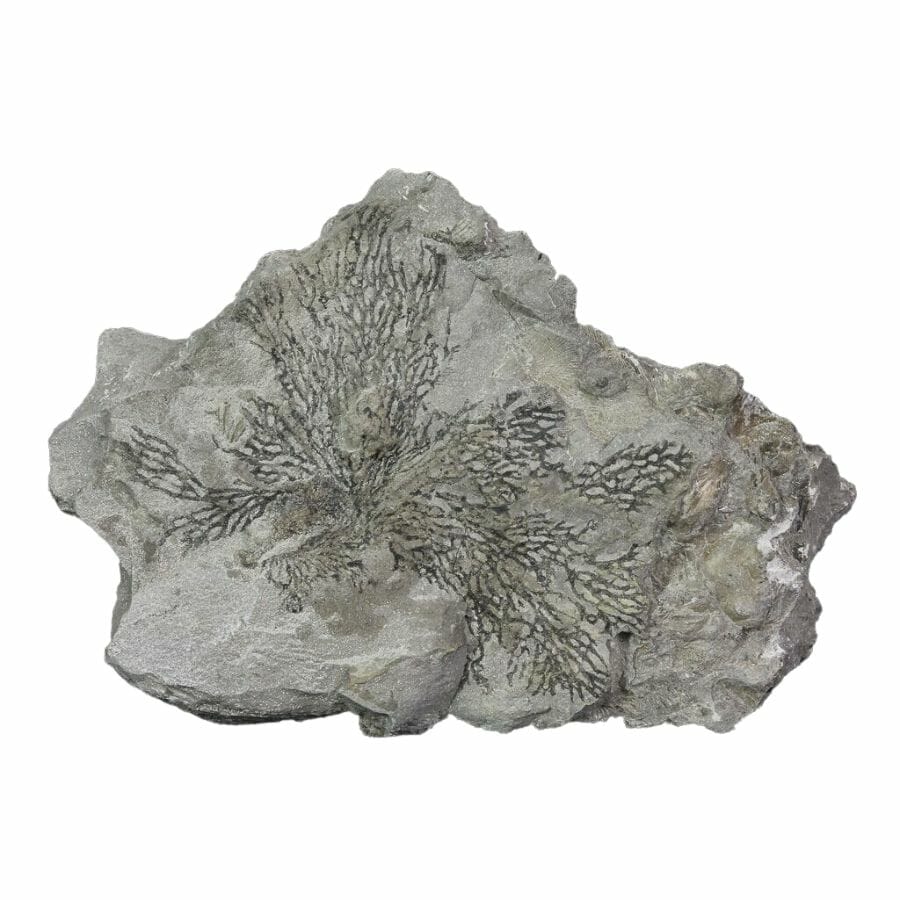
Here are the most frequently asked questions about the fascinating fossils that you might find in the state.
Can you find megalodon teeth or shark teeth in Indiana?
Finding megalodon teeth in Indiana might sound exciting, but it’s unlikely that you’ll find any.
Indiana, millions of years ago, was once covered by shallow seas. During this time, various sea creatures, including sharks, lived in these waters
However, megalodons, the massive prehistoric sharks, primarily inhabited saltwater oceans. Their teeth are more commonly found in coastal states or places once connected to those oceans.
On the other hand, smaller shark teeth have been found in Indiana. These are not from megalodons, but they’re still pretty cool!
If you’re keen on finding shark teeth or other marine fossils, certain riverbeds and rock layers in the state can be promising spots to start your search.
Always remember to hunt responsibly, respect private property, and keep the thrill of discovery alive.
Is it illegal to collect fossils in Indiana?
In Indiana, fossil collecting has some rules to ensure that everyone can enjoy and learn from these natural treasures. On Indiana public lands, such as state parks or nature reserves, collecting fossils is generally illegal.
You can find more information from the Indiana Department of Natural Resources.
This helps protect the environment and ensures that many people can see and learn from the fossils in their natural setting.
However, on private property, you can collect fossils with the landowner’s permission. It’s always important to ask first and respect their wishes.
If you’re given the green light, then you’re good to go! Just remember to collect responsibly, don’t take more than you need, and always leave the area as you found it.
There are also some special places called “collecting localities” where fossil enthusiasts can search and keep their finds. Just be sure to follow any rules or guidelines set for those areas.
Can you find dinosaur bones in Indiana?
Finding dinosaur bones in Indiana might not be as common as you’d hope. Indiana’s rocks mainly come from a time before the dinosaurs roamed the Earth or after they disappeared.
This means the layers where we’d expect to find dinosaur remains aren’t exposed at the surface. Instead, you’re more likely to discover fossils from sea creatures.
How do you identify the fossils that you find?
First, start by examining the shape and texture. Some fossils might look like shells, bones, or even plant leaves. Using a magnifying glass can help you see the details more clearly.
Next, think about the rock type you found it in. Different rocks can hold different kinds of fossils. For example, limestone often has marine creatures because it formed under the sea.
It’s also handy to have a fossil guidebook for your area. These books have pictures and descriptions that can help you match your find.
If you’re unsure, take a photo and share it with a local rock and fossil club or a geologist. They love helping and sharing their knowledge!
Remember, practice makes perfect. The more fossils you find and identify, the better you’ll get at recognizing them in the future.
Our Favorite Places To Buy Fossils In Indiana
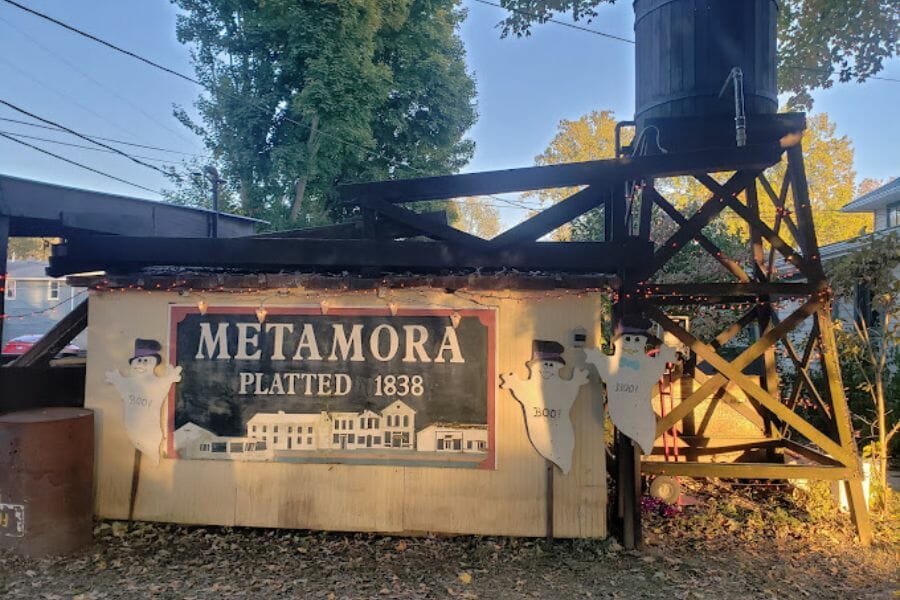
If you’re looking to buy some remarkable fossils, here are some of the best shops you can visit.
- Metamora Gem Mine And Luna’s Garden Gift Shop – 19055 Main St, Metamora, IN 47030
- Jox Rox Rock Shop – 4825 N Franklin Rd, Indianapolis, IN 46226
- Brown County Rock Shop – 79 N Van Buren St, Nashville, IN 47448
- I Dig Dinos NWI – 100 S Broad St, Griffith, IN 46319
- Geodes & Gemstones – 300 Hwy 35 N, Knox, IN 46534

